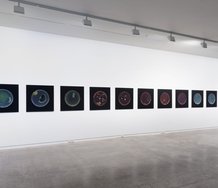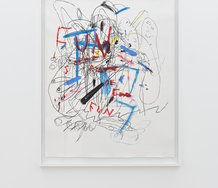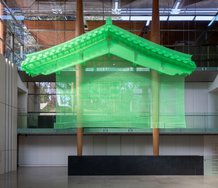John Hurrell – 11 June, 2012
In this type of work edges become important. They lead the eye to cut shape and the patterns enclosed within it - patterns that link up and form dominant rhythms. Many include lined up circles that look as if they have been cut around large plates, where synchronised flower/vase patterns take on the suggestion of gondolas. Other hybrids are more jagged and feature horizontal and perpendicular borders which for some reason merge more easily into the adjacent fabric.
These ‘paintings’ - which follow in the tradition of seventies ‘pattern’ artists like Miriam Schapiro, Joyce Kozloff, Robert Kushner, and (to some extent) Lucas Samaras - are the result of a collaboration between Elam graduate and gallery staff-member Zac Langdon-Pole and his mother (Cathy Pole). They recycle her discarded offcuts from a variety of fabrics by stitching several layers together and putting them on stretchers.
While these vertical rectangles are carefully composed they also exploit qualities such as misprints (poor registration) or unseen fabric borders, displaying ‘imperfect’ sections normally kept hidden. There is a casual and loose approach to their compositional placement, exploiting the given negative (removed) shapes within the large scraps as they have been found. There is nothing too fiddly with the reorganisation and are quite rough, with the occasional bit of thread dangling down.
In this type of work edges become important. They lead the eye to cut shape and the patterns enclosed within it - patterns that link up and form dominant rhythms. Many include lined up circles that look as if they have been cut around large plates, causing synchronised flower/vase patterns to take on the suggestion of hovering gondolas. Other hybrids are more jagged and feature horizontal and perpendicular borders which for some reason merge more easily into the adjacent fabric.
That blending or flow on effect often depends on how far away you are standing. If you are too close the juxtapositions remain discrete and too abrupt, so you have to adjust your distance. (This phenomenon also occurs with the British collage artist John Stezaker when you are examining his portrait/landscape blendings.) In Langdon-Pole’s case, with the clusters of leaves, stems and petals in the fabric, colourful landscapes emerge with different unanticipated foregrounds.
This artist is also exhibiting another less decorative variety of work - found ‘amateur’ paintings on linen that have been taken off their stretchers, flipped around and restretched, their backs now on show at the front. Little flicks of oil paint have seeped through, these random marks now suspended in isolation. Such stains or incrustations are related to Richard Maloy’s photographs of marked Elam desks, but embedded in a canvas weave. Or some of Johl Dwyer‘s recent plaster paintings.
I think if you owned one of these the temptation would be to constantly peek at the original painting now hidden, to try and find correlations between recto and verso. You’d be crazy not to, for pretending that the original image is out of sight (out of mind) and always unavailable defeats all logic. The gallery space enhances this mode of thinking by presenting some of these works on one-sided temporary walls that have their struts and mdf exposed on the other side. Just to remind you that what goes for the gallery is a possibility also for the work.
Round the back, in the small exhibiting space that is adjacent to the long office, is a display of items (selected by Langdon-Pole and constantly changing) from The Estate of L. Budd. Unsurprisingly (considering the terminology) the gallery handout tells us the fib that ‘she is believed to have passed away during the year 2005.’ Most of the work on the wall when I visited was not Budd’s art but photocopies of photographs of her work taken from pages of the Catalogue of Extant Works. That, incidentally, being for sale at a reduced price.
Langdon-Pole’s admiration is understandable. It fits in with the vague resemblance of his fabric paintings to some of Merylyn Tweedie’s more decorative wallpaper feminist collages from the late eighties. Possibly a teacher’s influence?
Overall, a stimulating and provocative exhibition. Its three shows make an unusual, enjoyable hang.
John Hurrell
 Advertising in this column
Advertising in this column Two Rooms presents a program of residencies and projects
Two Rooms presents a program of residencies and projects



This Discussion has 0 comments.
Comment
Participate
Register to Participate.
Sign in
Sign in to an existing account.